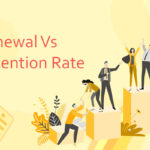
Eye-Catching Customer Retention Statistics For 2025
In 2025, customer experience has overtaken price and product as the key brand differentiator, according to CustomerThink. That means companies must start putting their customers first and focusing on providing a great experience if they want to stay ahead of the competition. But what does that mean for customer retention? How can companies keep their customers happy and engaged? Let’s see what the numbers tell us.
Key Customer Retention Statistics For 2024
– 78% of consumers expect an immediate response from brands when they reach out on social media (up from 73% in 2017). (Sprout Social)
– 72% of consumers say they would only buy more products from a company if it offered a personalized experience. (Accenture)
– 84% of consumers say they will likely leave a brand after just one bad customer experience. (Oracle)
– The top three traits that consumers look for in a company are fair prices (78%), good customer service (74%), and quality products (73%). (Accenture)
– After experiencing poor customer service, 96% of consumers will never do business with the company again. (American Express)
– Companies focus more on customer acquisition than retention: For every $100 spent on acquiring new customers, only $5 is spent on retaining existing ones. (Invesp)
– The average customer retention rate across all industries is 91%. (Invesp)
– The global churn rate is 5%. (Statista)
Customer Experience
Why do businesses invest in improving customer experience?
According to a study by Oracle, businesses that invest in improving customer experience see the following benefits:
– Increased customer loyalty: 68% of customers are likelier to stay with a company that offers a great customer experience.
– Improved customer retention rates: 59% of customers say they are likelier to stick with a company that offers a great customer experience.
– Greater customer lifetime value: 54% of customers say they are willing to spend more money with a company that offers a great customer experience.
How important is good customer service for business?
Very important, according to these statistics:
– 96% of consumers will never do business with a company after a bad customer service experience. (American Express)
– 89% of consumers have switched to doing business with a competitor after a poor customer service experience. (Accenture)
– Good customer service is the number one reason why people stay with a company (66%), followed by good value for money (61%) and good products or services (60%). (Accenture)
The Importance Of Personalization
Personalization is another critical factor in retaining customers. According to Accenture, 72% of consumers say they would only buy more products from a company if it offered a personalized experience. Furthermore, 69% of consumers say they are more likely to buy from a company that offers personalized recommendations, and 64% say they are more likely to return to a company that offers personalized experiences.
The Importance Of Price
Price is also an important factor in customer retention. 78% of consumers say they look for fair prices when choosing a company to do business with, making it the most crucial factor after good customer service and quality products.
The Importance Of Acquisition Vs Retention
Although customer retention is essential, many companies focus more on customer acquisition than retention. In fact, for every $100 spent on acquiring new customers, only $5 is spent on retaining existing ones.
The Global Churn Rate
The churn rate across all industries is 5%. It means that five of every 100 customers a company has leave in a given period. This number varies by industry, with some industries having higher churn rates than others. The telecom industry, for example, has a high churn rate of 14%, while the utility industry has a low churn rate of 2%.
Average Customer Retention Rate
The average customer retention rate across all industries is 65%. It means that for every 100 customers a company has, 65 stay with it over a given period. This number varies by industry, with some industries having higher retention rates than others. For example, the utility industry has a high retention rate of 89%, while the retail industry has a low retention rate of 46%.
The Difference Between Acquisition And Retention Rates
There is a big difference between customer acquisition rates and customer retention rates. The average customer acquisition rate is 20%, while the average customer retention rate is 65%. It means that for every 100 customers a company has, 20 are new, and 65 are existing.
How Much Businesses Invest In Customer Experience Technologies?
The research shows that in 2024, the global customer experience management market has reached $22.41 billion. This growth is driven by the need for businesses to improve customer satisfaction and loyalty.
Are Customers Willing To Give Their Info For A Great User Experience?
According to a study by Accenture, 72% of consumers are willing to share their personal information with companies to receive a more personalized experience.
How Much Businesses Earn If They Improve Customer Experience?
Businesses earn more than $1.6 trillion when they improve the customer experience. It is driven by the fact that happy customers are likelier to continue doing business with a company and recommend it to others.
Brand Loyalty
Do customers expect rewards for their loyalty?
According to a study by PwC, 87% of consumers said they would be more loyal to a company that offered rewards for their loyalty. It shows that customers value being rewarded for their loyalty and are likelier to continue doing business with a company that offers such rewards.
How often do customers purchase from the same brand?
Most consumers (60%) purchase from the same brand most of the time, while 20% always purchase from the same brand. It shows that brand loyalty is still essential to consumers.
What are the main reasons why customers switch brands?
The main reasons why customers switch brands are due to price (41%), poor customer service (32%), and a lack of selection (27%). It shows that businesses need to focus on providing a great customer experience and competitive prices to retain their customers.
If you want to improve your customer retention in 2025, book a demo right now.










